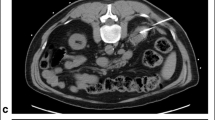Abstract
Purpose
Incidental detection of small renal masses has increased in recent years with increased use of various imaging modalities, and a substantial number of diagnoses are made in the elderly population. Minimally invasive surgical procedures have previously been established as options with excellent long-term oncological results, but surveillance strategies have more recently been introduced as alternatives for surgical intervention. This study reviews the outcomes for elderly patients treated with observation or surgery for small renal masses in order to better elucidate optimal management strategies.
Methods
A total of 4647 patients from the SEER database met criteria for inclusion in this study. Cumulative incidences of RCC-specific mortality and non-RCC-related mortality were estimated, and frequency distributions by tumor size and surgical status were calculated.
Results
No difference in RCC-related mortality was observed among all treatment groups, including surveillance, for tumors 1–30 mm in size. RCC-related mortality was significantly lower for surgically treated patients for all other tumor size groups. Mortality unrelated to RCC was significantly higher in patients undergoing surveillance compared to those undergoing surgical intervention for tumor sizes 1–30 or 1–40 mm.
Conclusions
A small renal mass in patients of 80+ years of age is best defined as up to 3 cm in size. For these patients, observation appears be a valid, if not preferential strategy. Patients 80+ years of age with renal masses greater than 3 cm still appear to benefit from surgical intervention.



Similar content being viewed by others
References
Green FL (2002) Kidney. In: Page DL, Batch CM, Fleming ID et al (eds) AJCC cancer staging manual. Springer, New York, pp 323–328
Jemal A, Siegel R, Ward E et al (2008) Cancer statistics, 2008. CA Cancer J Clin 58:71
Matthew A, Devesa SS, Fraumeni JF Jr et al (2002) Global increases in kidney cancer incidence, 1973–1992. Eur J Cancer Prev 11:171
Steffens S, Junker K, Roos FC et al (2014) Small renal cell carcinomas-How dangerous are they really? Results of a large multicenter study. Eur J Cancer 50:739–745
Volpe A, Panzarella T, Rendon RA et al (2004) The natural history on incidentally detected small renal masses. Cancer 100:738–745
Campbell SC, Novick AC, Belldegrun A et al (2009) Guideline for management of the clinical T1 renal mass. J Urol 182:1271–1279
Frank I, Blute ML, Cheville JC, Lohse CM et al (2003) Solid renal tumors: an analysis of pathological features related to tumor size. J Urol 170(6 Pt 1):2217–2220
Shuch B, Vourganti S, Ricketts J et al (2014) Definition early-onset kidney cancer: implications for germline and somatic mutation testing and clinical management. J Clin Oncol 32:431–437
Kunkle D, Egleston B, Uzzo R et al (2008) Excise, ablate or observe the small renal mass dilemma—a meta-analysis and review. Urol Oncol Biostat 179:1227–1234
Van Poppel H, Joniau S et al (2007) Is surveillance an option for the treatment of small renal masses? Eur Urol 52(5):1323–1330
NCCN clinical practice guidelines in oncology: kidney cancer, V 2.2014. http://www.nccn.org/professionals/physician_gls/pdf/kidney.pdf. Accessed 16 June 2014
Surveillance epidemiology and end results (SEER) Program (2015) SEER*Stat database: incidence—SEER 18 Regs research data + Hurricane Katrina impacted Louisiana cases, Nov 2014 Sub (1973–2012 varying)—linked to county attributes—total U.S., 1969–2013 Counties, Surveillance Systems Branch. In: DCCPS, Surveillance Research Program, Surveillance Systems Branch (eds) (trans: National Cancer Institute). Bethesda, Maryland
Gray B (2014) cmprsk: subdistribution analysis of competing risks, R package version 2.2-7. http://CRAN.R-project.org/package=cmprsk. Accessed 20 June 2014
(2015) R: a language and environment for statistical computing [computer program], version 3.1.3. R Foundation for Statistical Computing, Vienna, Austria
Kutikov A, Fossett LK, Ramchandani P et al (2008) Incidence of benign pathologic findings at partial nephrectomy for solitary renal mass presumed to be renal cell carcinoma on preoperative imaging. BJU Int 68:737
Remzi M, Ozsoy M, Klingler HC et al (2006) Are small renal tumors harmless? Analysis of histopathological features according to tumors 4 cm or less in diameter. J Urol 176:896
Acknowledgments
No affiliations, relationships, financial incentives, or conflicts of interest were associated with any of the authors with respect to the research conducted in this manuscript. All authors listed above contributed to and endorse this manuscript.
Author information
Authors and Affiliations
Corresponding author
Rights and permissions
About this article
Cite this article
Russell, D.H., Wachtel, M.S., de Riese, H.W. et al. Implications on clinical management of the small renal mass in patients 80 years of age and older based on a retrospective review of the SEER database. Int Urol Nephrol 47, 1503–1508 (2015). https://doi.org/10.1007/s11255-015-1058-1
Received:
Accepted:
Published:
Issue Date:
DOI: https://doi.org/10.1007/s11255-015-1058-1




